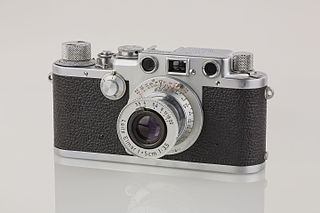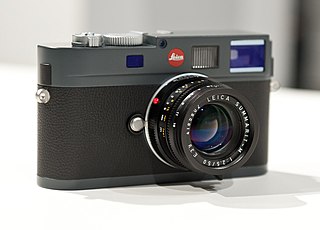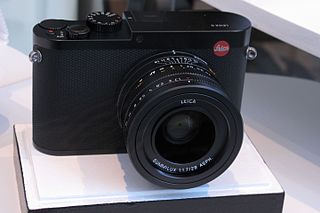
A single-lens reflex camera (SLR) is a camera that typically uses a mirror and prism system that permits the photographer to view through the lens and see exactly what will be captured. With twin lens reflex and rangefinder cameras, the viewed image could be significantly different from the final image. When the shutter button is pressed on most SLRs, the mirror flips out of the light path, allowing light to pass through to the light receptor and the image to be captured.

A camera is an optical instrument used to record images. At their most basic, cameras are sealed boxes with a small hole that allow light in to capture an image on a light-sensitive surface. Cameras have various mechanisms to control how the light falls onto the light-sensitive surface. Lenses focus the light entering the camera, the size of the aperture can be widened or narrowed to let more or less light into the camera, and a shutter mechanism determines the amount of time the photo-sensitive surface is exposed to the light.

A rangefinder camera is a camera fitted with a rangefinder, typically a split-image rangefinder: a range-finding focusing mechanism allowing the photographer to measure the subject distance and take photographs that are in sharp focus. Most varieties of rangefinder show two images of the same subject, one of which moves when a calibrated wheel is turned; when the two images coincide and fuse into one, the distance can be read off the wheel. Older, non-coupled rangefinder cameras display the focusing distance and require the photographer to transfer the value to the lens focus ring; cameras without built-in rangefinders could have an external rangefinder fitted into the accessory shoe. Earlier cameras of this type had separate viewfinder and rangefinder windows; later the rangefinder was incorporated into the viewfinder. More modern designs have rangefinders coupled to the focusing mechanism so that the lens is focused correctly when the rangefinder images fuse; compare with the focusing screen in non-autofocus SLRs.

135 film, better known as 35 mm film, is a format of photographic film used for still photography. It is a cartridge film with a film gauge of 35 mm (1.4 in), typically used for hand-held photography in 35 mm film cameras. Its engineering standard for the film is controlled by ISO 1007.

Leica Camera AG is a German company that manufactures cameras, lenses, binoculars, rifle scopes, microscopes and ophthalmic lenses. The company was founded by Ernst Leitz in 1869. The name Leica is derived from the first three letters of his surname (Leitz) and the first two of the word camera: lei-ca.

A digital single-lens reflex camera is a digital camera that combines the optics and the mechanisms of a single-lens reflex camera with a digital imaging sensor.

The Leica M8 is the first digital camera in the rangefinder M series introduced by Leica Camera AG on 14 September 2006. It uses an APS-H 10.3-megapixel Kodak KAF-10500 CCD image sensor.

The Leica M mount is a camera lens mount introduced in 1954 with the Leica M3, and a range of lenses. It has been used on all the Leica M-series cameras and certain accessories up to the current film Leica M-A and digital Leica M10 cameras.

The Konica Hexar RF is a 35 mm rangefinder camera which was sold by Konica. It was introduced to the market on 13 October 1999. and subsequently discontinued some time before the end of 2003. The camera used the "Bayonet Konica KM-mount", a copy of the Leica M-mount, thus sharing interchangeable lenses with those designed for Leica cameras and others compatible with them. The Hexar RF has a combined rangefinder/viewfinder modeled on that of Leica cameras, a similar body shape and size - and so is similar to Leica M-mount cameras in many aspects of operation.

A mirrorless interchangeable-lens camera (MILC), frequently simply mirrorless camera, also called DSLM, and sometimes also called EVIL features a single, removable lens and uses a digital display system rather than an optical viewfinder. The word "mirrorless" indicates that the camera does not have a reflex mirror or optical viewfinder like a conventional digital single-lens reflex camera (DSLR), but an electronic viewfinder which displays what the camera image sensor sees.

The Leica M Monochrom is a full-frame digital rangefinder camera of Leica Camera AG, and features a monochrome sensor. The camera was announced on May 10, 2012. Delivery started September 2012 in black finish only. A Leica M Monochrom in Silver was announced May 22, 2014.

The Leica M-E is a digital rangefinder camera manufactured by Leica Camera. It was released on 17 September 2012. The M-E is Leica's first entry-level rangefinder model, with a technical specification that is nearly identical to the Leica M9, and based around the same 18MP full frame CCD sensor. It does not offer the M9's built-in USB port, but keeps pace with an identical 2 frames per second continuous shooting mode, built-in flash with hot shoe and Leica's classic rangefinder design. The M-E does not have a frame-lines lever, it preselects the correct frame-line for any lens when it is attached. The M-E, like the M9 and the M Monochrom was made of brass around a magnesium chassis. The M-E is only available with an anthracite grey paint finish.

The Leica M is a full-frame digital rangefinder camera of Leica Camera AG. It was introduced in September 2012, and is the successor to the Leica M9 range of cameras. The M uses a 24-megapixel image sensor. The camera is the first M model to feature movie recording, and the first to have Live View, which allows the scene, as viewed through the lens, to be composed. The M can use most M- and R-mount lenses. Leica M cameras are made by hand in Portugal and Germany. There is also a version, the M Monochrom, with a monochrome, rather than colour, sensor.

The Leica Q is a full-frame fixed-lens camera announced by Leica on June 10, 2015. The Leica Q2 was announced in March 2019.
The Leica M is a digital rangefinder camera announced by Leica Camera on November 19, 2015. The shutter and cocking mechanism are much quieter than in the earlier and higher-priced M Typ 240, and allow two frames per second to be recorded in single shot mode. The model omits the Typ 240's live view and video capabilities, and has a much simpler menu structure and one-button access to white balance settings. The Leica M has a CMOS full-frame sensor with a 24 Megapixel resolution, with an ISO of up to 6400. The usual brass camera body has been replaced with an aluminum alloy top plate, for a reduction in weight.

The Leica M10 is a full-frame digital rangefinder camera in Leica Camera AG's rangefinder M series. It accepts Leica M-mount lenses. The camera model was introduced on 19 January 2017.
The Leica M-A is a purely mechanical 35 mm rangefinder camera released by Leica Camera AG in 2014. The camera has no exposure meter, no electronic control, and no battery is required to operate it. The camera is Leica's first purely mechanical camera since the release of the Leica M4-P in 1981.
The Leica M-E is a digital rangefinder camera announced by Leica Camera on June 24, 2019. The Leica M-E is an 'entry-level' model in Leica's M mount of rangefinder cameras. It features a 24 Megapixels full-frame CMOS sensor, Leica's Maestro processor, and a 2GB buffer for sustained burst capture. Video can be captured at 1080/30p. As with all Leica M-series models, the camera is hand-built and weather-sealed. The camera is essentially a Leica M but is made with alloy metals which is lighter than the usual brass top and bottom plates. The camera is finished in "Anthracite Paint" with black leather wrap.
The Leica M Monochrom is a digital rangefinder camera manufactured by Leica Camera. It was released on 30 April 2015. The Leica M Monochrom uses a full frame 24 Megapixels CMOS sensor that, like its predecessor the Leica M Monochrom, has no color filter array. It is therefore Leica's second black and white only camera. It is essentially a monochrome only version of the Leica M. The M Monochrom offers an increase in ISO range up to ISO 25,000, a new 3 inches 921,000-dot LCD screen and live view shooting including focus peaking and 10x magnification. Also included is full HD video recording.

The Leica M10-D is a digital Rangefinder camera released by Leica Camera on 24 October 2018. The M10-D succeeds the Leica M-D in the Leica no-LCD screen line of digital cameras. Otherwise the M10-D is similar to the Leica M10, but instead of the rear screen, the back contains an exposure compensation dial in black. Unlike the M-D, the M10-D has a dedicated ISO dial on the top plate. The M10-D also has a film advance lever, which functions only as a stylised thumb rest. Other than the exposure, ISO, aperture and shutter speed settings, all other settings must be made via the Leica Fotos app. The app allows the camera to connect with a smartphone via Wi-Fi. The M10-D has a 24 MP sensor and Maestro II processor. It offers an ISO of up to 50000 and a 5 frames per second burst rate.

















